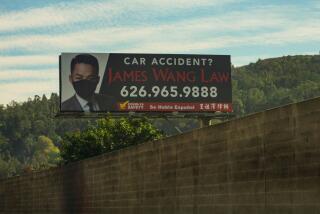Ads of ‘90s Will Go ‘One-on-One’ With Consumers, Aim for the Heart
- Share via
Until now, the rules of advertising have always been simple enough.
Assume that the viewer has the intelligence of an artichoke. State the name of the product at least once every millisecond. Don’t ever advertise such sure-fire snoozers as the safety features of products. Avoid those larger-than-life--if not murky--issues like the eroding environment. Keep the length of TV commercials to a manageable minute, at most. And try to create ads that appeal to the most diverse audience possible--say, the entire Western Hemisphere.
Well, folks, those were the old rules. And they may have been darned good for the 1950s, ‘60s, ‘70s and much of the ‘80s. But they won’t fly in the ‘90s. In fact, say top executives from many of the nation’s largest ad firms, it’s going to be a brave new world of advertising.
“The rules, as we’ve known them, will all go out the window,” said Ed Wax, president and chief executive of the New York agency Saatchi & Saatchi Advertising, which creates ads for Burger King and Tide detergent. “The rules used to work because consumers were predictable. About the only thing that’s predictable now is that when viewers don’t like your ad, they’ll zap it.”
As a result, not only will advertising look different in the ‘90s, it will also try to approach consumers differently.
“The ‘90s will be the decade of one-on-one advertising,” said Graham Phillips, chairman and chief executive of Ogilvy & Mather Worldwide, which creates ads for such companies as American Express and Seagram. “Advertising will become much more personal as industries try to zero in on their targets.”
In fact, Phillips predicts that during the next decade it will be relatively common for households to receive on their cable-TV stations commercials that are specifically selected for them. And a number of magazines’ subscribers will discover ads inside the publications that were specifically written for them--with their names appearing in them.
“This isn’t just the advertising business any more,” Phillips said. “It’s the marketing services business.”
Some executives say that, over the next decade, marketing researchers will stop at nothing to find out information on consumers. “Big Brother will be watching and listening like never before,” said Los Angeles ad man and consultant Stan Freberg. “It’s J. Edgar Hoover as J. Walter Thompson.”
In the ‘90s, advertising agencies will be asked to do a lot more than create ads. “Agencies that want to keep their clients will have to offer more strategic ideas for marketing products,” said Robert Schmidt, chairman of the New York agency Levine, Huntley, Schmidt & Beaver, which creates ads for Subaru and Dreyfus Corp.
The business of advertising will become a lot more than that of simply grabbing the attention of TV viewers and magazine readers. In the ‘90s, carefully crafted and psychologically driven ads will become the benchmark.
“If you know what car someone drives and what magazine he reads, you can get a pretty good idea of what he’s like,” said Ogilvy’s Phillips. “And the more you know about someone, the more likely you are to create advertising that can push his or her button.”
For those ad executives with a background in psychology, the ‘90s could be their decade. “There will be a lot less bean counting and a lot more in-depth, psychological probing to know all the nuances of consumers,” said Charles D. Peebler Jr., chief executive of the New York-based Bozell, which creates ads for Chrysler and American Airlines. “We will all need a deeper understanding of what makes people tick.”
For years, advertisers have been basically satisfied if people just remember their ads. That might not be good enough in the ‘90s. “The Holy Grail will no longer be an ad recall score,” said Richard Fizdale, president of Leo Burnett, the Chicago agency that develops ads for Oldsmobile and Kellogg Co. “The question won’t be, ‘Did you remember the ad?’ The question will be, ‘Did it persuade you to act?’ ”
How to persuade?
Well, advertisers are already latching onto some of those issues that they believe will hit closest to the hearts of consumers during the ‘90s: health, safety and the environment.
“The environment will be the driving force of the ‘90s,” said ad chief Schmidt. “It wouldn’t surprise me to see companies like Exxon running five-minute editorial ads that explain their points of view on certain environmental issues.”
Executives say this is a monumental change. “A few years ago, the surest way for a commercial to fail was for it to sell safety or talk about health issues,” said Norman W. Brown, chairman and chief executive of FCB Communications Inc., the giant Chicago ad firm that handles ads for Mazda and the California Raisin Advisory Board. “But the environment and health considerations have started to become important to a significant number of people.”
Some predict that the environment may become to advertising of the ‘90s what nostalgia was to advertising of the ‘80s. “It’s much bigger than McDonald’s,” said Fizdale, of his agency’s biggest client, which recently began to install separate trash bins at some stores for paper and non-paper waste. “Every single client is going to have to respond to the ‘green’ movement.”
Indeed, product advertisements that may appear more akin to public service spots--and that have a greater awareness of the frailty of life on earth--may fill our TV screens in the ‘90s, said Richard Lord, chairman of Lord Einstein O’Neill & Partners in New York.
“A little while ago, my agency was considering taking on a fur account,” Lord said. “But then we realized no one in the creative department was willing to work on it. Something like that was unthinkable not too many years ago.”
Lord’s agency recently began to film a series of ads for car maker Saab that look the safety issue square in the eyeball. Lord doesn’t want to reveal the content of the ads, which won’t air until March. But he says they will attempt to show dramatically that Saab is one of the safest cars sold. “Will that help us sell cars?” poses Lord. “You bet it will.”
Then, there are those executives who say they aren’t much interested in hitching on to any trends. Nor do they think they can forecast the future.
“No one can predict what advertising will be like in the 1990s,” said Philip B. Dusenberry, chairman of the New York office of BBDO Worldwide, which creates ads for Pepsi. “Most of those predictions are a lot of baloney. But with all the new brands that will be on the market in the ‘90s, that will require even more personal--perhaps, more emotional--advertising. You know, advertising that is closer to the bone.”
During much of the ‘80s, the techniques used to film ads became trendier than the ideas that were in the ads themselves, said Jay Chiat, chairman of Chiat/Day/Mojo in Venice, creator of spots for Eveready batteries that feature the mechanical bunny that walks off the set. “You had things like the MTV look and the shaky-camera look being knocked off consistently. They all became techniques without ideas.”
But one thing that was true in the ‘80s will still be true for advertising in the ‘90s, Chiat said. “There’s no substitute for a great idea.”
Lexus Recall Won’t Be End of ‘Perfection’ Ads
It had to be plenty embarrassing for the new Lexus division of Toyota to recall most of its cars last week. But imagine how red-faced executives were at the company’s El Segundo ad agency, which has portrayed the car as being virtually flawless.
Of course, agency executives are keeping a stiff upper lip. “All we’ve been getting to date are compliments about the car,” said Jim Hirschboeck, president of Team One Advertising, a division of Saatchi & Saatchi DFS, which last week also picked up the Lexus advertising account in Australia. As for the Lexus recall, said Hirschboeck, “We don’t see this as a problem.”
Despite the recall of 8,000 Lexus LS 400 models--to make three minor repairs on each vehicle--the agency says Lexus will continue to stick with the ad slogan: The relentless pursuit of perfection.
“When you’re pursuing something relentlessly,” said Hirschboeck, “it suggests you’ll never attain your goal.”
Paul Newman Does Ad for American Express
Paul Newman seems to have finally caved in to Madison Avenue.
The renowned actor, who has declined for years to appear as a product spokesman on American television, has filmed a commercial for American Express that some expect may air in late January during the Super Bowl.
Both American Express and Newman’s public relations firm declined to comment on the story line of the commercial, which was filmed late last month in Bakersfield by the ad agency Ogilvy & Mather.
But Newman’s Los Angeles publicist says he will probably donate all the proceeds to charity. “If I were a betting man,” said Warren J. Cowan, chairman of Rogers & Cowan, “I’d say that’s where the money will go.” Newman’s food company, which makes spaghetti sauce and popcorn, has donated more than $20 million to charity.
Executives at American Express--who are also said to be negotiating with actress Meryl Streep--say they have tried to get Newman to star in an ad for nearly 10 years. Advertisers see it as a major coup to land any celebrity that the general public knows won’t appear in ads. After all, it can greatly add to any product’s credibility.
Rival Visa recently signed ex-Beatle Paul McCartney to a high-profile contract. American Express executives say McCartney aides approached them about sponsoring his concert tour, but they declined when it became clear that the multi-city tour could not make tickets for his concerts readily available to American Express cardholders.
“We’re very excited to be working with someone of Paul Newman’s stature,” said Nancy Muller, vice president of public affairs at American Express. “‘It’s a tribute to the personal bond he has with American Express.”
And yes, Newman is a longtime cardholder.
More to Read
Inside the business of entertainment
The Wide Shot brings you news, analysis and insights on everything from streaming wars to production — and what it all means for the future.
You may occasionally receive promotional content from the Los Angeles Times.










